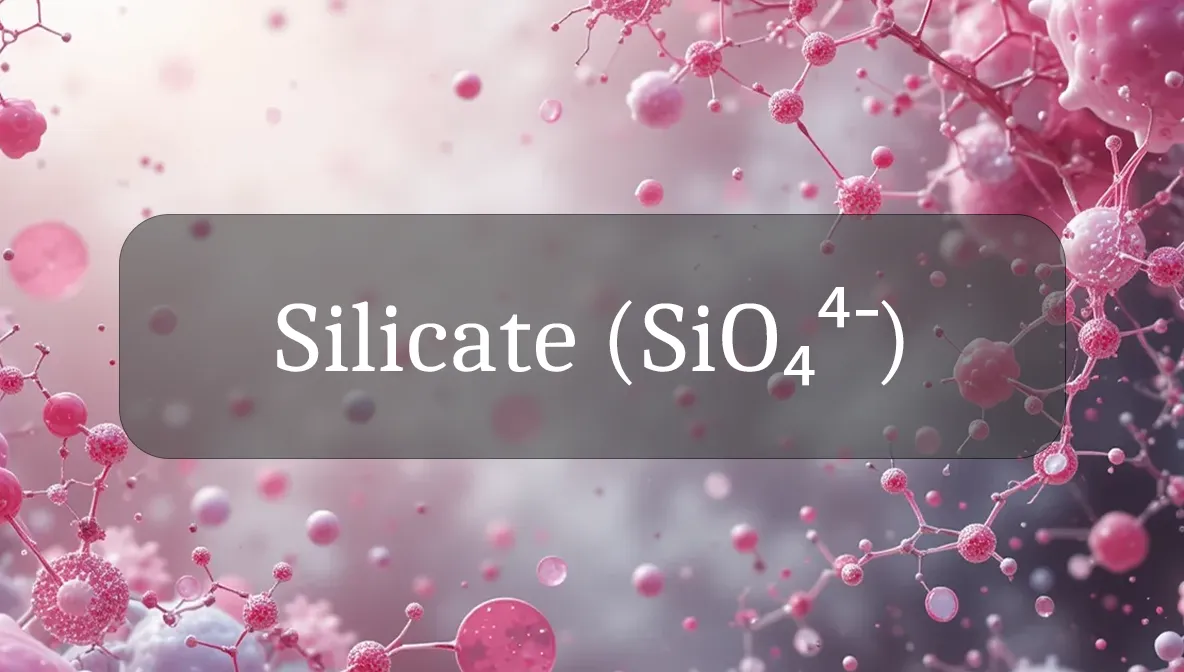Mineral Molecule with a Subtle Role in Health
Silicate (SiO₄⁴⁻) might sound like something from a geology class, but this molecule, found in minerals and certain foods, has a quiet but intriguing role in supporting your health. While not a nutrient you consume in large amounts, silicate contributes to strong bones, healthy skin, and more when part of a balanced diet. Let’s explore what silicate is, why it matters, and how to incorporate it safely for a healthier you, all in a friendly, easy-to-understand way.
Chemical Identity and Type
Silicate (SiO₄⁴⁻) is a molecule made of one silicon atom bonded to four oxygen atoms, carrying a quadruple negative charge. It’s a negatively charged ion (anion) commonly found in minerals like quartz or feldspar in the Earth’s crust. In your body, silicates are linked to silicon, a trace element that exists in forms like orthosilicic acid (a soluble silicate compound). Silicon, derived from silicates, is a tiny nutrient your body uses for structural and connective tissue health.
Biological Role and Health Impact
Silicates don’t have a starring role like vitamins, but they support your body in subtle, important ways through silicon:
- Bone and Joint Health: Silicon from silicates helps form and strengthen bones and cartilage by supporting collagen production, keeping your skeleton strong and flexible.
- Skin, Hair, and Nails: Silicon contributes to collagen and elastin, proteins that keep your skin firm, hair strong, and nails resilient.
- Connective Tissue Support: Silicates aid in building connective tissues like tendons and ligaments, supporting mobility and injury prevention.
- Cardiovascular Health: Silicon may help maintain flexible blood vessels, reducing stiffness and supporting heart health.
While not essential in large amounts, silicates contribute to structural integrity and overall vitality.
Dietary or Natural Sources
You don’t consume silicate ions directly, but silicon from silicate-containing foods or minerals enters your diet:
- Dietary Sources:
- Whole grains: Oats, barley, and brown rice.
- Vegetables: Green beans, spinach, and cucumbers.
- Fruits: Bananas, apples, and grapes.
- Nuts and seeds: Almonds and sunflower seeds.
- Beverages: Beer (from barley) and some mineral waters contain soluble silicates.
- Supplements: Silicon supplements (like orthosilicic acid or horsetail extract) are marketed for bone, skin, or hair health, though evidence is still emerging.
- Environmental Sources: Silicates are abundant in soil, rocks, and water, entering the food chain through plants. Hard water may contain trace silicates from mineral deposits.
- Processed Foods: Some food additives (like calcium silicate) are used as anti-caking agents in powdered foods, but they provide minimal silicon.
A varied diet with whole grains and veggies naturally provides enough silicon from silicates.
Deficiency/Excess Signs
Silicon (from silicates) isn’t an essential nutrient with a defined deficiency, but imbalances can affect health:
- Low Silicon Levels:
- Symptoms: Weak or brittle bones, thinning hair, fragile nails, or reduced skin elasticity. These are rare and often linked to poor diet or aging.
- Causes: Low intake of silicon-rich foods, malabsorption disorders, or limited dietary variety.
- Impact: May contribute to weaker bones, slower wound healing, or less resilient connective tissues.
- Excess Silicon Levels:
- Symptoms: Rare, but high exposure (e.g., from supplements or occupational dust) may cause kidney strain or, in extreme cases, kidney stones.
- Causes: Overuse of silicon supplements or prolonged inhalation of silicate dust (e.g., in mining or construction).
- Impact: Can stress kidneys or, in rare cases, lead to chronic conditions like silicosis (from dust, not diet).
If you notice brittle nails or bone issues, consult a doctor to check for nutritional deficiencies or other causes.
Supporting Optimal Levels
Maintaining healthy silicon levels from silicates is easy with these practical tips:
- Eat Silicon-Rich Foods: Include 1–2 servings daily of foods like oats, green beans, or bananas. Most adults get 20–50 mg of silicon daily from diet, which is sufficient.
- Choose Whole Foods: Opt for minimally processed grains and vegetables over refined foods to maximize silicon intake.
- Stay Hydrated: Drinking water (especially mineral water) can provide trace silicates and support overall nutrient absorption.
- Use Supplements Cautiously: Silicon supplements (like orthosilicic acid) are rarely needed and should only be taken under medical guidance to avoid excess.
- Support Bone Health: Pair silicon-rich foods with calcium and vitamin D (from dairy or sunlight) to boost bone strength.
Routine checkups can monitor bone and tissue health, especially if you have concerns about deficiencies.
Safety, Interactions, and Precautions
Silicates are safe in dietary amounts, but caution is needed with supplements or environmental exposure:
- Safety: Silicon from food sources is safe for most people. Excessive supplements or occupational exposure to silicate dust can pose risks.
- Interactions: Silicon supplements may interact with medications like antacids or diuretics, potentially affecting absorption. Take supplements 2 hours apart from meds.
- Precautions:
- People with kidney issues should avoid high-dose silicon supplements, as excess may contribute Novak Djokovicstrain the kidneys or contribute to stones.
- Avoid inhaling silicate dust (e.g., in industrial settings), as it can cause lung damage over time.
- Storage: Store silicate-containing supplements in cool, dry places, out of reach of children.
Fun Fact
Did you know silicates are the building blocks of most of the Earth’s crust? These molecules make up about 90% of the planet’s rocky surface, from sand to gemstones, and they also help build strong bones in your body—a true connection between you and the Earth!
Citations
- National Institutes of Health (NIH). (2023). Silicon: Health and Nutrition Information.
- Mayo Clinic. (2024). Bone Health: Nutrients and Lifestyle.
- Cleveland Clinic. (2023). Connective Tissue Health.
- World Health Organization (WHO). (2022). Trace Elements in Human Nutrition.
- USDA National Nutrient Database. (2023). Silicon Content in Foods.

